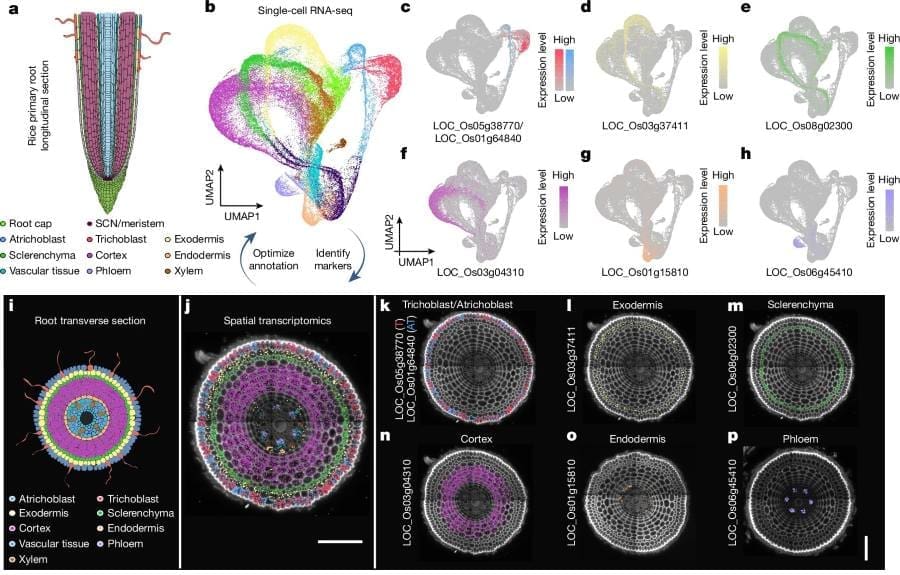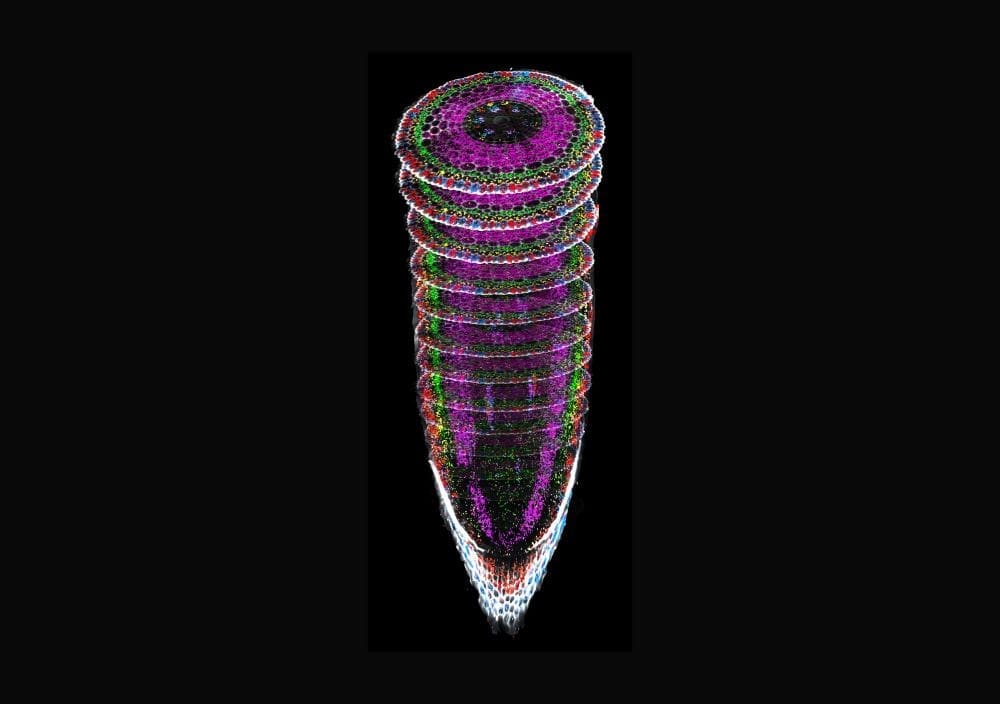Summary:
Plant roots are not just passive anchors in the ground — they are highly responsive organs that sense and adapt to the complex environment of soil. In a study published in Nature, an international team led by researchers at the University of Nottingham, alongside collaborators from the USA and Belgium, has uncovered how individual root cells in rice respond to different soil conditions. Using spatial transcriptomics and single-cell RNA sequencing, the scientists compared rice roots grown in artificial gel-based media with those in natural, compacted soils. They found striking differences in gene expression among outer root cells, revealing responses tied to nutrient uptake, cell wall structure, and defense mechanisms.
One of the most compelling findings involved the stress hormone abscisic acid (ABA), which helped reinforce internal barriers in root tissues to reduce water loss in compacted soils. The team also employed phonon microscopy to measure how root cell walls stiffen in response to mechanical stress — akin to how humans reinforce structures before a storm. This study not only provides a cellular map of how roots respond to real soil conditions but also opens new doors to engineering climate-resilient crops by understanding root behavior at unprecedented resolution.

New study unlocks how root cells sense and adapt to soil
Scientists have discovered, for the first time how root cells respond to their complex soil environment revealing that roots actively sense their microenvironment and mount precise, cell-specific molecular responses. The findings could help the development crops that are resistant to climate stress.
In a study, an international team of plant scientists and engineers from the University of Nottingham have worked with teams in the USA and Belgium. The team used cutting-edge spatial and single-cell transcriptomics to compare rice roots grown in conventional gel-based media with those grown in heterogeneous natural soils and hard soils.
One striking discovery involved the hormone abscisic acid (ABA), known for its role in water stress. The study showed ABA helps reinforce waterproofing barriers, reducing water loss from roots and aiding their resilience to hard soils. This insight offers a potential key to engineering crop roots with improved resilience to hard soil conditions.
Soil is the foundation of life on land, producing over 90% of all terrestrial food. Yet, this dynamic ecosystem is far from uniform: it presents a constantly changing mosaic of nutrients, water availability, microbial life, and mechanical challenges. Understanding how root cells sense and respond to soil stresses is vital for future-proofing global food security.
“Seeing genes related to nutrient sensing, water response, and biotic stress light up ONLY in soil-grown roots was awe-inspiring,” said first author Mingyuan Zhu of Duke University. “It was a striking moment that made the complexity of root-soil environment interactions feel vividly real.”

Dr Bipin Pandey from the University of Nottingham’s School of Biosciences led the Nottingham research, he said: “This is the first time such cell-resolution expression tools have been applied to roots grown in soil. Understanding root cell-specific responses in a realistic soil environment will pave the way for engineering crops at the cellular level — tailored to work without disrupting critical processes in other root tissues.
This breakthrough research exemplifies the power of interdisciplinary collaboration and represents a paradigm shift in plant biology — transforming our ability to study processes in root cells from controlled lab conditions to the much more challenging, but realistic, conditions plants experience in soil. As climate change threatens soil quality and agricultural sustainability, such insights are not just scientifically exciting — they are essential.”
The study also showed that the activation of plant response systems is not only regulated by genetic or biochemical process, but one that physically changes the plant’s material properties on a cellular level. In collaboration with the University of Nottingham’s Faculty of Engineering, the team used a new cellular resolution imaging technology called phonon microscopy to map changes in cell wall stiffness for roots grown in stressed and unstressed environments.
“We have discovered this incredible capability for plant roots to effectively ‘brace for impact,’ by stiffening their cell walls, when grown in soil that has been compacted,” said Dr Salvatore La Cavera from the University of Nottingham’s Faculty of Engineering. “Plants prepare for extreme conditions almost like humans using sandbags to brace for a storm. By better understanding the material properties of plants we can help engineer plants with enhanced physical attributes that are better suited for our changing environment.”
The study also stands as a heartfelt tribute to the late Professor Philip Benfey, a key collaborator whose visionary ideas and approaches helped shape and launch this project. Professor Malcolm Bennett from the University of Nottingham has led this area of research and worked with Professor Benfey and commented: “Philip was very passionate about this area of research and the innovative techniques being pioneered,” said. “We are proud to have helped bring his dream to reality.”
Journal Reference:
Zhu, M., Hsu, CW., Peralta Ogorek, L.L. et al., ‘Single-cell transcriptomics reveal how root tissues adapt to soil stress’, Nature (2025). DOI: 10.1038/s41586-025-08941-z
Article Source:
Press Release/Material by University of Nottingham
Featured image credit: University of Nottingham



